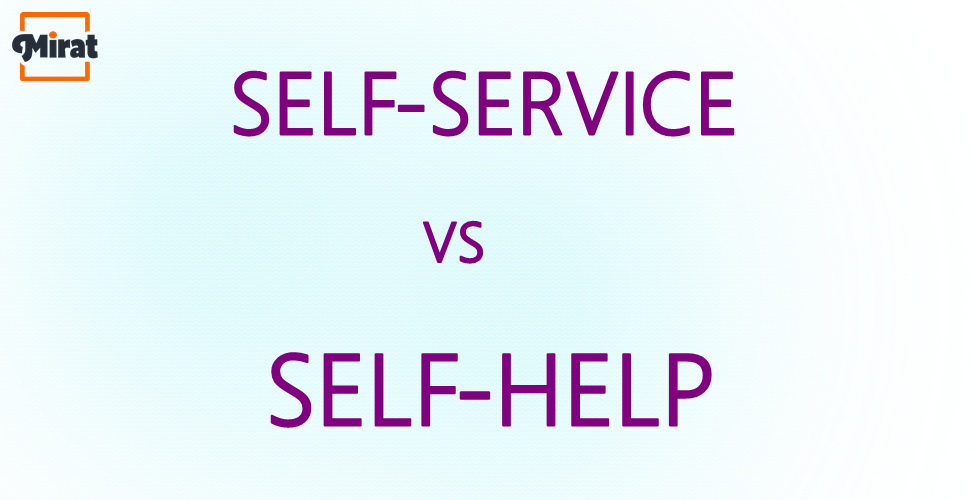Numerous associations are beginning to understand the advantages of executing self-service, particularly as we get through the blowback of the COVID-19 pandemic. Providing a stable support and extending assistance for help desk work and your far off staff is a necessary during these times.
Furthermore, clients like IT self-service and self help too in light of the fact that it’s fast and simple, and they progressively need to have the option to help themselves. Truth be told, a study showed that – at least 91% of respondents would utilize an information base assuming it were accessible and custom-made to their requirements. This is exactly what MIRAT does. MIRAT’s custom-made IT self service system is tailor-made to suit customer needs.
While self-service is just helpful, and fruitful, it’s working for the client and, over and over again, IT associations aren’t perceiving this. All things considered, their IT self-service abilities are possibly planned rapidly (with practically zero client input), executed in a rush, and afterward left to do its thing. Then, at that point, when it definitely doesn’t proceed as well as guaranteed, IT self-service gets a terrible standing.
IT self-service isn’t quite so basic as individuals expect. It requires huge investment and exertion and your IT association should be “in it for the long-run.” If you’re searching for a fast, short-term fix for your issues, then IT self-service won’t work.
What the IT business currently calls self-service got going especially with an attention on the assistance list or, to be more exact, the help demand index. Be that as it may, what was needed by clients, and sold by ITSM programming merchants, was far beyond an assistance demand list – it was a range of “self-service” capacities.
Be that as it may, even this isn’t sufficient to precisely depict what numerous IT offices are as yet attempting to persuade workers to embrace – with “self-service,” as a term, still maybe inadequate to portray the full range of “self” abilities.
IT Self Service Vs Self-Help
You may want to believe that these two things are different yet comparable with possibly all self-service capacities are self-help based, yet not all self help abilities are self-service oriented.
Sounds befuddling, however assuming we move away from IT self-service briefly to take a gander at this according to the representative viewpoint, what amount of what’s recorded in the following area down could they think about IT self-service and how much self-help? Particularly considering what workers do and encounter in their own lives with business-to-shopper (B2C) organizations.
Scanning Google for a response to a clothes washer issue – it’s self help whether a definitive arrangement comes from a maker FAQ segment, a blog, or a local area webpage.
Looking on the web for a train time – most likely self help, except if the data got is thought of as a “service” and the action is viewed as a substitution to calling a helpline or approaching a data stall. The provider is offering an assistance, yet is it actually a self-service movement attempted by the client? It’s better to stay with self help.
Talking with a web-based B2C support agent about an item’s abilities – it’s simply one more help station, a choice to phone, email, or self-help.
What’s more, in the initial three cases, I’d risk everything believes themselves to be “helping themselves” as opposed to “serving themselves.”
Self Service & Self Help In ITSM
Similarly that ITSM is – according to ITIL – 26 cycles and four capacities, self-administration is far beyond what was recently pushed. At the point when self-administration was categorized as a productivity expanding, cost-saving, and better experience conveying a valuable open door for workers than select new or transformed IT administrations from a web-based assistance (demand) inventory.
All things being equal, IT self-service could incorporate some or all of the accompanying model abilities – and here’s where this blog begins to take a gander at what IT self-service truly is: Getting to accommodating data. From “how-to” advisers for YouTube recordings – the worker helps themselves, so it’s self improvement (or do you suppose they serve themselves with data/information on an item/administration?).
Mentioning or requesting of new IT administrations. It’s certainly self-administration. Regardless of whether individuals are involved at the back-end.
Logging issues for goal by the IT administration work area. It’s not exactly self improvement – as there’s no prompt assistance (except if computerization is capable kick-in to determine at the purpose in logging). Nor is it self-service – as there’s no quick result. Best case scenario, it’s some type of “taking care of oneself” instrument where someone, or something, somewhere else necessities to follow through with something.
Really taking a look at the situation with an episode or solicitation. In the event that data is an assistance, it’s self-service, however at that point that would make the getting to of supportive data self-service as well.
Admittance to visit capacities. This may be the underlying passage for help/administration or an acceleration point for when self-service issues emerge. One way or the other, it most likely isn’t self-anything until talk and “self-service” combine as chatbots.
Distributed help. Admittance to networks, gatherings, and other friend support components. This must be self help, assuming that friends are viewed as “living information articles.”
Admittance to programming downloads. In the event that computerized and moment, it’s self-administration.
Admittance to IT-resource data. To figure out IT resource choices and distributions and possibly to take an interest in resource reviews. It’s more taking care of oneself than it is self-service or self help, and more self improvement than self-service.
So what amount of what’s at present packaged under the IT self-service umbrella truly self-service?
Maybe one could contend that a basic differentiator is that assistance demand related abilities are self-service and episode goal related capacities are self help?
The underlying straightforward models and the arrangement of capacity slugs above are ideally sufficient to make you imagine that eliminating human assistance and help – or causing the end client to accomplish something themselves – shouldn’t naturally make a movement “self-service.”
Self help is different to self-service. Also, it’s possibly more enthusiastically to get right, considering that self improvement depends intensely on information the executives – something that associations have determinedly attempted to get right.
Associations gaining from the disappointments and accomplishments of others, and Better self-service capacities presented inside ITSM toolsets
Both adding to an ascent in self-service accomplishment on the rear of new ITSM-apparatus execution projects.
If it’s not too much trouble, read on to comprehend the advantages of, challenges connected with, and ways to prevail with, self-service. On the whole, we should check out at the condition of oneself help country.
Self-service ought to be a critical piece of the IT support environment – helping end clients/clients and IT staff the same. In any case, the IT business as the need might arise to get better at hitting the nail on the head.
Industry research by both HDI and SDI over and over shows that IT associations keep on battling with self-service.
Self-service can absolutely supplant at least one existing access and correspondence channels, for example the phone.
Simply carrying out self-service innovation is enough for individuals to utilize it.
Any ITSM suite’s self-service innovation is adequate for progress.
Schedule a trial/demo with MIRAT today to learn more about Mirat.ai’s IT Infrastructure Management and its benefits. Mirat.ai’s IT ticket management software is Affordable & Easy to use! Get your Dashboard ready in only 5 minutes. Contact us now!
Contact Information:
Hema
Sales Executive
Phone: +1-315-636-4213
Email: sales@mirat.ai
Website: https://www.mirat.ai/

